You are using an out of date browser. It may not display this or other websites correctly.
You should upgrade or use an alternative browser.
You should upgrade or use an alternative browser.
Not sure what you are referring to. How to blacken brass?How is that made? I believe its not blackening... that makes the guns black. I think the brass cannon would have been look like dark metalic brown, or dark bronze,
Would appreciate a tip.
john
I know exactly what you're trying to do, since I'm currently working on a 17th century vessel with bronze cannons (culverins / demi-culverins). I used this: Brass Darkening Solution. It did a great job of darkening brass to a rich bronze color in about 10 minutes or less. Make sure that all lacquer or other coatings are removed from the barrels and that you wash them in acytone or denatured alcohol, and only handle them with rubber gloves, or the finish will not come out even. Oils from your fingers will prevent an even reaction, and make a mottled appearance.
I originally tried putting the brass barrels in a sealed container, suspended above a puddle of weight vinegar for two days, but the results were a rough, dark and easily rubbed off coloration. The darkening solution does a better job.
For white metal barrels found in the next model I am building, i have to resort to bronze metallic paint. Bronzed brass cannons look much better.
I originally tried putting the brass barrels in a sealed container, suspended above a puddle of weight vinegar for two days, but the results were a rough, dark and easily rubbed off coloration. The darkening solution does a better job.
For white metal barrels found in the next model I am building, i have to resort to bronze metallic paint. Bronzed brass cannons look much better.
Hi KURT do you have a brand name or a link to the product. THANKS Don
Cannons could never have been made of brass...they would have exploded into a million pieces, killing multiple crew members. In the 17thcentury, bronze was used, but gave way to the much less expensive cast iron which was essentially black.
This is the stuff:Hi KURT do you have a brand name or a link to the product. THANKS Don
Brass Darkening Solution
Cannons could never have been made of brass...they would have exploded into a million pieces, killing multiple crew members. In the 17thcentury, bronze was used, but gave way to the much less expensive cast iron which was essentially black.
What confuses people today is that bronze is referred to in old documents as brass. Bronze is almost as expensive today as it was back then. It's a copper/tin allow. Brass is a copper/zinc alloy. I've used bronze in the fittings of Roman suits of armor. I absolutely love working with it. You can temper it into springs, you can anneal it and shape it like copper, and you can machine or cast it. The trouble is, tin supply in the world is largely mined out. The Romans went to Great Britain and as far north as Scotland to get more tin after the supply around the Mediterranean was virtually mined out.
@DARIVS ARCHITECTV wuao! That does is it! Thank very much sir. The only question is how do you finish (interupt) the darkening processes? Do you just take it out of the solution? Wash it wit water, or paint it with a colourless protective?
And if I may a second question. If you go to far darkening can it be reversed through acetone or lemon etc?
Thanks again for your response and of course for sharing your precious knowledge.
Christos
@DocBlake metallurgy: Bronze and brass are both cooper alloys. Cannons were normally made from bronze, not brass. Bronze alloy has less zinc (its a tin-zinc alloy) and is harder. Brass has more zinc and is softer. Brass has a more yellowish colour, while bronze has a more reddish colour.
Still in the english language there seems to be a confusion in the use the of the terms brass and bronze cannons.We have the same confusion in the greek language as well.
Bronze that is used for guns (just as an example:10–14% Sn, 2–3% Zn, 0–0,8%P) it is also called red brass or even gun metal.
And if I may a second question. If you go to far darkening can it be reversed through acetone or lemon etc?
Thanks again for your response and of course for sharing your precious knowledge.
Christos
@DocBlake metallurgy: Bronze and brass are both cooper alloys. Cannons were normally made from bronze, not brass. Bronze alloy has less zinc (its a tin-zinc alloy) and is harder. Brass has more zinc and is softer. Brass has a more yellowish colour, while bronze has a more reddish colour.
Still in the english language there seems to be a confusion in the use the of the terms brass and bronze cannons.We have the same confusion in the greek language as well.
Bronze that is used for guns (just as an example:10–14% Sn, 2–3% Zn, 0–0,8%P) it is also called red brass or even gun metal.
Last edited:
@DARIVS ARCHITECTV wuao! That does is it! Thank very much sir. The only question is how do you finish (interupt) the darkening processes? Do you just take it out of the solution? Wash it wit water, or paint it with a colourless protective?
And if I may a second question. If you go to far darkening can it be reversed through acetone or lemon etc?
Thanks again for your response and of course for sharing your precious knowledge.
Christos
@DocBlake metallurgy: Bronze and brass are both cooper alloys. Cannons were normally made from bronze, not brass. Bronze alloy has less zinc (its a tin-zinc alloy) and is harder. Brass has more zinc and is softer. Brass has a more yellowish colour, while bronze has a more reddish colour.
Still in the english language there seems to be a confusion in the use the of the terms brass and bronze cannons.We have the same confusion in the greek language as well.
Bronze that is used for guns (just as an example:10–14% Sn, 2–3% Zn, 0–0,8%P) it is also called red brass or even gun metal.
Leave the cannons in the solution until they are dark enough. A few minutes should do. If you need them darker, just put them back in for a while longer. It works pretty fast. The trick is ensuring that the metal is CLEAN. Rinse the solution off with water when done, and wipe them gently with a cloth to remove any roughness. The metal should have some shine to it even though oxidized. Coat the barrels with lacquer or varnish to preserve the oxidation layer, but the layer is robust enough to leave as-is. The lacquer may add more gloss, but I prefer the metallic look as-is. It's a matter of preference.
If for any reason you want to remove the patina and start over, dipping the barrels into boiling hot vinegar or washing in most any light acid like lemon juice will pickle the oxides right off. If you want to make the highlights a little brighter, buffing with a cloth will yield a nice effect.
Here are my 9 pound culverins on the deck of La Couronne. These are painted a bronze color, but they look exactly like the brass cannon barrels I oxidized for the next model, HMS Sovereign of the Seas. Aside from the metallic shininess, they blend in with the wood of the carriages.
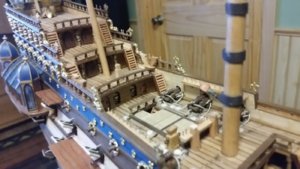
Last edited:
@DARIVS ARCHITECTVS Beautiful! Awesome! Thats what I had in mind... thinking that may be that was impossible to achieve, but you have patiently explained and demonstrated that it can be made. Great!
Thank you for your detailed and clear explanations and for all your precious help.
Christos
Thank you for your detailed and clear explanations and for all your precious help.
Christos
Anytime.
Don't forget to show us what you make!
Don't forget to show us what you make!
Last edited:
- Joined
- Feb 15, 2019
- Messages
- 279
- Points
- 168

Many cannons were made of bronze (I live close to the Royal Armory Museum, Portsmouth) If a bronze cannon was damaged they could salvage the metal and recast it. Use concentrated liquid ammonia (hardware store oven cleaner) and put 10mm deep in a jam jar with a sealable lid. With a bit of rigging line hang the brass to be coloured over (not in) the liquid. Please do this operation reasonably quickly, you'll understand later! A cannon can be left for a few hours, wire tends to go too brittle so only a few minutes. The patina will also have some green verdigris, this can be removed with fine steel wool. You may want to repeat for longer until you get the shade required.How is that made? I believe its not blackening... that makes the guns black. I think the brass cannon would have been look like dark metalic brown, or dark bronze,
Would appreciate a tip.
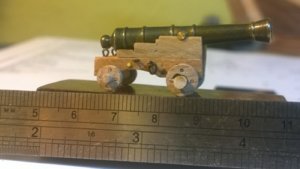
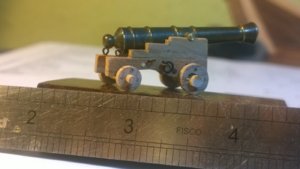
@Bob Ellis thank you very much for your response and informative post. Indeed your cannons look amazing real
- Joined
- Feb 15, 2019
- Messages
- 279
- Points
- 168

Can't help I'm afraid, never used it. You can't ruin a cannon by experimenting I assume??Just love your bronze cannons, Bob.
My question....I bought some 'liver of sulpher'. It arrived in a clear pink solution. After a while it turned colourless, with a few black specs floating around. Does this stuff have a shelf life?
- Joined
- Oct 15, 2017
- Messages
- 986
- Points
- 403

I have struggled a little in the past with getting to the "appearance" cannon as well. Personally, I don't care for the look of raw brass. Like many members I use Birchwood Casey's Brass Black with good results. The process I use is to dilute the Brass Black, 1 part Brass Black to 5 parts water. It will allow you to get to the same results if you used straight Brass Black, it just takes a little longer....about 5 times longer. And since the process is slower it allows me to watch and remove the cannon when it reaches the depth of black I'm looking for. I then remove and rinse under regular water.How is that made? I believe its not blackening... that makes the guns black. I think the brass cannon would have been look like dark metalic brown, or dark bronze,
Would appreciate a tip.
With all this said, I do like to make the cannon as well as all the model's components have a little more realistic look and slightly weathered, if I can. I was able to find another product on the market, by Sculpt Nouveau, called Tiffany Green, Traditional Patina.
Below you can see the cannon on the left was using straight Brass Black. The cannon on the right I used Brass Black 1to5 solution and let the cannon get to about 1/3rd the depth of black that you see on the left cannon. I then, rinsed and let it dry. I sprayed (misted) the cannon with the Tiffany Green (it comes with its own spray nossle) and let it progress till I thought I was happy with the look. Let it dry and am pretty happy with the results. These are very small guns for the 1/90 scale Satisima Trinidad project I'm working on so detail is less important than 1/48 scale. But it still gives you the illusion of corrosion and aging.
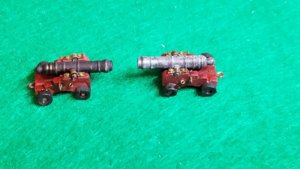
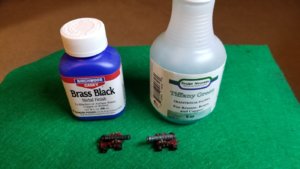
What is a little strange is that in the photo the looks a little grayer than it really is. In real setting (not the photo) it is slightly greener like salt water corrosion.
I hope this helps you a bit
You can always remove the oxide coating if you don't like the appearance and start over using a different method. There is no appreciable metal loss.Can't help I'm afraid, never used it. You can't ruin a cannon by experimenting I assume??



